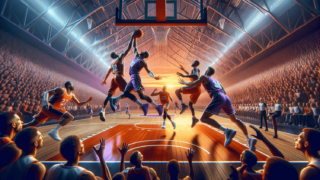
In the fast-paced world of basketball, every second counts, and a split-second decision can make all the difference in the final outcome. Enter the ‘Quick Shot’ – a fascinating and strategic move that has left many newcomers to the game curious and eager to learn more about its mechanics and nuances. This blog post delves into the realm of quick shots, providing an in-depth analysis on this exciting play style while balancing fun and professional insights. Get ready to level up your basketball knowledge as we explore what it takes to become a quick shot maestro on the court!
What’s a Quick Shot in Basketball?
A quick shot in basketball refers to a rapid release of the ball while shooting, usually within a few seconds upon receiving the pass or creating space offensively. This swift action aims to exploit openings in the defense or capitalize on fast-break opportunities before the opposition has time to adequately contest or position themselves defensively. Quick shots can be employed by players of all positions and can be executed through various forms, such as jump shots, layups, or three-pointers.
Understanding the Quick Shot Dynamics
The quick shot in basketball represents a player’s ability to swiftly identify an opportunity and capitalize on it by releasing the shot as quickly as possible. It requires a blend of skill, timing, and court awareness to execute effectively. In this post, we’ll break down the different aspects of the quick shot, from the mechanics of the shot itself to scenarios in which it can be most beneficial.
The Art of the Quick Shot: Techniques and Mechanics
Before diving into the various situations where a quick shot can be most advantageous, it’s essential to understand the mechanics behind this dynamic play. This section will cover some of the critical techniques that make an efficient quick shot in basketball.
Proper Shooting Form
A successful quick shot starts with a solid foundation in shooting form. When taking a quick shot, it is crucial to maintain proper shooting mechanics—legs shoulder-width apart, balanced weight distribution, knees slightly bent, and non-shooting hand used to guide the shot. By maintaining good form, a player can achieve accuracy and consistency, even under the pressure of a fast-paced game.
Finding Your Rhythm
One of the essential aspects of mastering the quick shot is identifying your shooting rhythm. Players must learn to synchronize their shooting motion with their body’s natural cadence. By perfecting this synchronization, a player can both maintain control over the shot and react swiftly to various game situations.
Developing a Quick Release
One of the hallmarks of an effective quick shot is a speedy release. The faster a player can get the shot off without sacrificing accuracy, the more likely they are to catch the defense off-guard. To develop a quick release:
- Minimize the time between catching the ball and starting your shooting motion.
- Keep the ball close to your body, maximizing control while minimizing wasted motion.
- Streamline your shooting form, focusing on fluid movements toward the rim.
- Stay square to the basket, as this will grant better control over the direction and accuracy of your shot.
Spotting Opportunities for the Quick Shot
Recognizing when to deploy a quick shot is crucial in making this play effective. Many elements in a basketball game affect your decision-making, but the primary factors that present opportunities for quick shots are spacing, mismatches, and defensive lapses.
Creating and Exploiting Space
One primary goal of an offensive player is creating enough space to either score or set up an open teammate. One way to do this is by setting screens to help shooters find separation. As a shooter, being able to recognize space and capitalize quickly with a shot is key to a successful scoring opportunity.
Capitalizing on Mismatches
Another leading cause of quick shot opportunities in basketball involves mismatches. This occurs when a slower or less-skilled defender is matched up against a more skilled offensive player. Players should recognize mismatches early and respond with a quick shot to capitalize on this window of opportunity.
Seizing Defensive Lapses
Defenses in basketball are not perfect and occasionally suffer from lapses in coverage or awareness. Identifying these moments and responding with a quick shot can be instrumental in generating points for your team while also punishing the opposing defense for their mistakes.
Implementing the Quick Shot in Different Game Situations
Now that we have covered the mechanics and situational aspects of the quick shot, let’s explore some game situations where this style of play can be most impactful in basketball.
The Fast-Break Quick Shot
One common scenario where quick shots can be highly effective is during fast-break situations when the defending team is caught off-guard. Pushing the ball upcourt with high tempo allows for offensive players to take advantage of momentarily lax defenses, creating just enough room for a quick shot before the opposing team has a chance to recover and contest the attempt.
The Role of Quick Shots in Offensive Systems
Coaches often integrate quick shots into their offensive schemes as a tactic to disrupt or exploit the opposing defense. The goal is to create more efficient scoring opportunities by moving the ball quickly around the court to spacing advantages or mismatches that benefit the team’s shooters. This can involve using quick shots in response to defensive overcommitment, such as double-teaming or closing out too aggressively on the perimeter.
Playmaking with the Quick Shot
Court vision and playmaking ability are key to maximizing the effectiveness of quick shots in basketball. Elite players can not only execute quick shots themselves but also find open teammates for these attempts. Effective playmaking involves understanding your teammate’s shooting tendencies and recognizing the moments when they can catch the defense off-guard with a quick shot.
Developing a Quick Shot Mentality
Mastering the quick shot requires not only skill, technique, and court awareness, but also a mentality supported by confidence and assertiveness. This section will offer key pointers in establishing an effective quick shot mentality on the basketball court.
Playing with Confidence
Moving with decisiveness and assertiveness is vital in executing a quick shot effectively. A confident approach involves trusting your shooting abilities, seeking out shot opportunities, and never hesitating to pull the trigger in the right moment.
Maintaining a Shooter’s Mentality
A shooter’s mentality is one where the player maintains a relentless focus on scoring, even during periods when shots might not be falling. One missed shot should never deter a player from being ready to take the next open look. With a quick shot, shooters must remain mentally prepared for the next opportunity to present itself, translating into fluid shooting motion and steady confidence during high-pressure situations.
Improving Through Practice and Repetition
Finally, the most effective way to develop a quick shot mentality in basketball is by practicing consistently and diligently. From refining essential shooting mechanics to simulating game conditions that challenge your ability to make quick decisions, sustained practice and repetition will ultimately determine your success in executing quick shots on the basketball court.
In summary, the quick shot in basketball is a multifaceted element of the game that can offer a significant edge to teams and players when utilized effectively. By understanding and implementing proper techniques, recognizing game situations ripe for quick shots, and cultivating a conscientious quick shot mentality, players can elevate their offensive impact and overall performance on the court.
Defensive Strategies Against Quick Shots
As vital as it is to master the quick shot, understanding how to defend against it is equally crucial for basketball players. In this section, we will delve into the defensive strategies and approaches in neutralizing the effectiveness of those quick release attempts from the opposition.
Communication and Team Coordination
One of the most effective ways to counter quick shots on the defensive side of the ball is through excellent communication and team coordination. Alerting teammates to potential shooting threats, calling out screens, and keeping everyone engaged can help reduce the number of open looks and quick shot opportunities for the offensive team.
Quick and Precise Closeouts
Another fundamental aspect of defending against quick shots is executing quick and precise closeouts on shooters. When a shooter catches the ball and seems prepared to take a quick shot, defenders must close out with control and purpose to contest the shot effectively. Key pointers for a successful closeout include:
- Maintaining a low and balanced stance.
- Approaching the shooter with short, choppy steps for more excellent control.
- Keeping arms up and actively contesting the shot without fouling.
- Being ready to react to potential pump fakes or dribble moves.
Anticipation and Defensive Positioning
Anticipating quick shots and being proactive with defensive positioning can also help limit these scoring opportunities. By staying a step ahead and understanding an opposing player’s shooting tendencies or the team’s offensive schemes, defenders can better position themselves and react faster to contest a quick shot attempt.
The Evolution of Quick Shots in Modern Basketball
As the pace of professional basketball continues to accelerate, the relevance and importance of quick shots have grown in tandem. Here, we will briefly explore how quick shots have evolved throughout the history of basketball and their current influence on the game.
The Rise of the Three-Pointer
In the modern era of basketball, the value of the three-point shot has grown exponentially. Teams are placing a higher emphasis on spacing, providing more room for their shooters to fire away from beyond the arc. Consequently, mastering the quick shot has become increasingly necessary, given the tighter defensive coverage on perimeter shooters nowadays.
Increased Pace and Offensive Style
Another aspect of the game contributing to the increased significance of quick shots is the general uptick in the pace of play. Offenses aim to initiate scoring opportunities more quickly, and defenses are forced to adapt and contest shots with ever greater urgency. As a result, players incorporating quick shots into their repertoire are better prepared to excel in this high-tempo game environment.
Player Versatility and Positionless Basketball
The emergence of positionless basketball has given rise to more versatile players who can function in various roles on the court. This shift has prompted players of all positions to improve their shooting skills, including the quick shot. As a result, mastering this aspect of the game has become increasingly important for players seeking to maximize their impact and maintain a competitive edge.
With the ever-evolving nature of basketball and the growing importance of quick shot execution, any player looking to excel at the highest level should continually enhance their understanding and development of this vital skill.
Frequently Asked Questions
If you’re seeking additional insights into the world of quick shots in basketball, take a look at our comprehensive FAQ section. We’ve gathered frequently asked questions on this topic, along with concise answers to help you satisfy your curiosity and expand your knowledge of this fascinating aspect of the game.
1. What makes a quick shot effective in basketball?
Quick shots are effective because they exploit weaknesses in the defense, such as mismatches, lapses in coverage, or improper closeouts. Additionally, they catch defenders off-guard and force them to adjust, in turn creating further scoring opportunities for the offensive team.
2. How do I improve my quick shot release?
To improve your quick shot release, practice maintaining proper shooting form, focus on a smooth shooting motion, stay square to the basket, and reduce the time between receiving the ball and initiating your shot. Consistent practice and repetitions will help you achieve a faster release without compromising accuracy.
3. How can I tell when to take a quick shot during a game?
Recognize when the opportunity presents itself for a quick shot by evaluating factors such as spacing, mismatches, and defensive lapses. Generally, it is a good time for a quick shot when there is ample space or if you have a mismatch with a slower or less capable defender.
4. How can quick shots help during fast-break situations?
During fast-break situations, defenses are often scrambling to cover the offensive players. Quick shots capitalize on defensive confusion, creating scoring opportunities before the opposition can recover and contest the attempt, thereby increasing your team’s chances of scoring.
5. How can I practice quick shots effectively?
Include drills in your practice sessions that simulate game conditions, challenge your decision-making, and focus on rapid shooting. Some examples of practice drills are catch-and-shoot, shooting off the dribble, and reaction-based shooting drills that involve recognition of different game situations.
6. How do I create space for quick shots?
Creating space for quick shots involves utilizing screens, off-ball movements, and effective dribbling. Mastering the art of shaking off your defender and making yourself available for passes will result in more opportunities for quick shots.
7. Can all players benefit from incorporating quick shots in their game?
Yes, players of all positions can benefit from incorporating quick shots into their game, as it increases their versatility on offense and forces defenders to remain on their toes. However, guards and wings primarily utilize quick shots due to their shooting prowess and agility.
8. How can I defend against quick shots?
Few strategies to defend against quick shots include effective communication, proper positioning, anticipation, and controlled closeouts. These tactics can disrupt the shooter’s rhythm, force them to think twice before attempting a shot, or lead to contested, low-percentage attempts.
9. How do coaches incorporate quick shots into team strategies?
Coaches often integrate quick shots into offensive schemes to generate more efficient scoring opportunities. They focus on ball movement, spacing, and exploiting mismatches to create openings for their shooters, taking advantage of defensive overcommitment or miscommunication.
10. Are quick shots more crucial in specific periods of a game?
Quick shots can be utilized effectively throughout a game; however, they can be particularly impactful in situations where teams aim to gain momentum or disrupt defensive setups. That said, strategic timing based on mismatches or defensive lapses is more essential than a particular period of the game.
11. How have quick shots evolved in basketball?
Quick shots have evolved with the increasing significance of the three-point shot, faster pace of play, and the emergence of positionless basketball. These factors have made quick shot execution an increasingly important skill for players across different positions.
12. What are some examples of NBA players with exceptional quick shot abilities?
Some examples of NBA players with remarkable quick shot abilities include Stephen Curry, Klay Thompson, and Damian Lillard. These players exhibit rapid release times, precision, and accuracy that make them difficult to defend.
13. What impact does the quick shot have on an opposing team’s defensive strategy?
The quick shot forces opposing defenses to be more proactive, aware, and aggressive in their closeouts. It also demands continuous communication and coordination among defenders to minimize quick shot opportunities and keep up with the fast-paced nature of the offensive team.
Featured Posts
- No pillar pages found.





